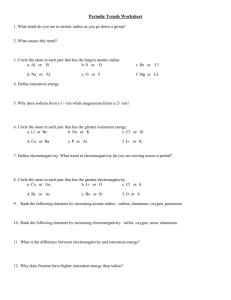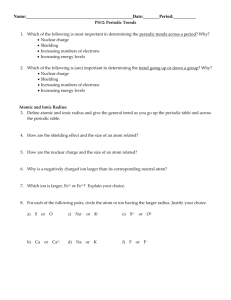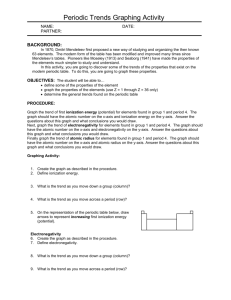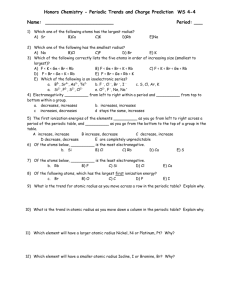Periodic Trends
advertisement
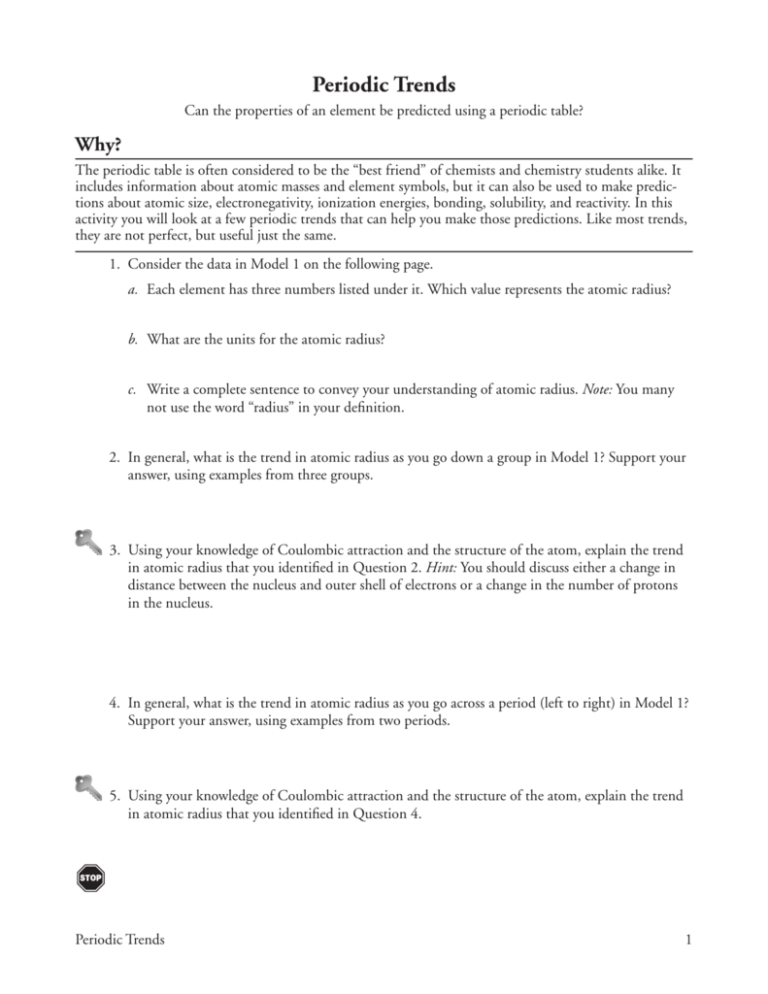
Periodic Trends Can the properties of an element be predicted using a periodic table? Why? The periodic table is often considered to be the “best friend” of chemists and chemistry students alike. It includes information about atomic masses and element symbols, but it can also be used to make predictions about atomic size, electronegativity, ionization energies, bonding, solubility, and reactivity. In this activity you will look at a few periodic trends that can help you make those predictions. Like most trends, they are not perfect, but useful just the same. 1. Consider the data in Model 1 on the following page. a. Each element has three numbers listed under it. Which value represents the atomic radius? b. What are the units for the atomic radius? c. Write a complete sentence to convey your understanding of atomic radius. Note: You many not use the word “radius” in your definition. 2. In general, what is the trend in atomic radius as you go down a group in Model 1? Support your answer, using examples from three groups. 3. Using your knowledge of Coulombic attraction and the structure of the atom, explain the trend in atomic radius that you identified in Question 2. Hint: You should discuss either a change in distance between the nucleus and outer shell of electrons or a change in the number of protons in the nucleus. 4. In general, what is the trend in atomic radius as you go across a period (left to right) in Model 1? Support your answer, using examples from two periods. 5. Using your knowledge of Coulombic attraction and the structure of the atom, explain the trend in atomic radius that you identified in Question 4. Periodic Trends 1 Model 1 – Main Group Elements 1 H 37 1312 2.1 3 Li 4 Be 152 520 1.0 11 Na 186 496 0.9 19 K 160 738 1.2 20 Ca 227 404 0.8 143 578 1.5 31 Ga 8 O 9 F 77 1086 2.5 14 Si 71 1402 3.0 15 P 66 1314 3.5 16 S 71 1681 4.0 17 Cl 70 2081 N/A 18 Ar 117 786 1.8 32 Ge 122 558 1.7 7 N 83 801 2.0 13 Al 197 550 1.0 6 C 112 900 1.5 12 Mg 5 B 2 He 31 2372 N/A 10 Ne 115 1011 2.1 33 As 123 709 1.8 125 834 1.9 Atomic Number Element Symbol Electron Shell Diagram 104 1000 2.5 34 Se 117 869 2.1 99 1251 3.0 35 Br 114 1008 2.5 98 1521 N/A 36 Kr 112 1170 N/A Note: The transition elements and f-block elements have been removed from the periodic table here to ease the analysis of the trends. Atomic Radius (pm) 1st Ionization Energy (kJ/mol) Electronegativity 2 POGIL™ Activities for High School Chemistry 6. Locate the numbers in Model 1 that represent the ionization energy. The ionization energy is the amount of energy needed to remove an electron from an atom. a. Using your knowledge of Coulombic attraction, explain why ionization—removing an electron from an atom—takes energy. b. Which takes more energy, removing an electron from an atom where the nucleus has a tight hold on its electrons, or a weak hold on its electrons? Explain. 7. In general, what is the trend in ionization energy as you go down a group? Support your answer using examples from three groups. 8. Using your knowledge of Coulombic attraction and the structure of the atom, explain the trend in ionization energy that you identified in Question 7. 9. In general, what is the trend in ionization energy as you go across a period? Support your answer using examples from two periods. 10. Using your knowledge of Coulombic attraction and the structure of the atom, explain the trend in ionization energy that you identified in Question 9. 11. Atoms with loosely held electrons are usually classified as metals. They will exhibit high conductivity, ductility, and malleability because of their atomic structure. Would you expect metals to have high ionization energies or low ionization energies? Explain your answer in one to two complete sentences. Periodic Trends 3 Read This! Electronegativity is a measure of the ability of an atom’s nucleus to attract electrons from a different atom within a covalent bond. A higher electronegativity value correlates to a stronger pull on the electrons in a bond. This value is only theoretical. It cannot be directly measured in the lab. 12. Using the definition stated in the Read This! box above, select the best visual representation for electronegativity. Explain your reasoning. A B C D 13. Locate the electronegativity values in Model 1. a. What is the trend in electronegativity going down a group in Model 1? b. Explain the existence of the trend described in part a in terms of atomic structure and Coulombic attraction. c. What is the trend in electronegativity going across a period in Model 1? d. Explain the existence of the trend described in part c in terms of atomic structure and Coulombic attraction. 14. The two diagrams below can summarize each of the three trends discussed in this activity. Write “atomic radius,” “ionization energy,” and “electronegativity” under the appropriate diagram. High Low 4 Low High POGIL™ Activities for High School Chemistry
